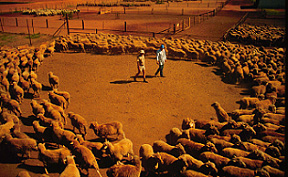


This photo illustrates the flight zone of a herd of sheep.

Center track double rail restrainer. Livestock are riding the conveyor in a comfortable, upright position. This is a very humane method of restraint.


Grandin, T. 1995
Restraint of Livestock.
Proceedings of Animal Behaviour, Design of Livestock and Poultry Systems
International Conference.(pages 208-223)
Published by: Northeast Regional Agriculture Engineering Service,
Cooperative Extension
152 Riley - Robb Hall
Ithaca, New York, 14853
USA
Grandin, T. (Editor) 1993
Livestock Handling and Transport.
CAB International, Wallingford Oxon, United Kingdom
Grandin, T. 1988
Double Rail Restrainer For Livestock Handling
Journal of Agricultural Engineering Research 41:327-338